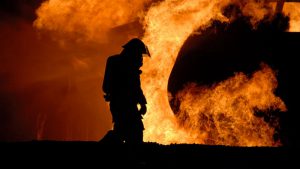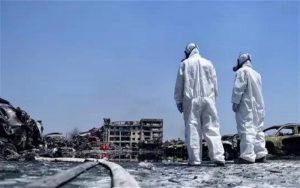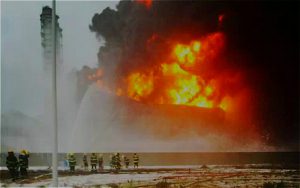The clean-up following the August 12 Tianjin warehouse explosion is proving more complex than previous industrial accidents in China, mainly because of the hazardous chemicals involved and the disaster’s close proximity to residential areas. Various options are available to restore the site, with action taken at past accident sites helping to inform the work, but there is still widespread concern about the effectiveness of the current clean-up – not least from local residents.
Official reports say the site was storing about 1,300 tonnes of
oxidizing agents, such as ammonium nitrate and potassium nitrate, and 500 tonnes of flammable materials, including metallic sodium and magnesium. But it is still unclear which materials have polluted the site and whether chemical reactions have led to secondary pollution, said Wang Qi, head of the Institute for Solid Waste Pollution Control in the Chinese Research Academy of Environmental Sciences.
In previous cases, pollution occurred over a long period of time, enabling easier identification of sources of contamination and the extent and geographical spread of pollution. In Tianjin, it is much more difficult to calculate the environmental impact of chemicals that were dispersed violently by the explosion into the air, soil and water.
Since August 16, the city has been monitoring soil at 73 points within a five kilometre radius of the explosion. On August 22, cyanide compounds were identified in 16 samples to the south and north-east of the site, although authorities said these were not at dangerous levels. Analysis of samples taken from deeper underground is continuing.
But some soil restoration experts say 73 monitoring points is far too small a number to provide a full picture of the pollution at Tianjin. One specialist, who is a member of the Chinese Academy of Sciences, says the normal number of monitoring points would be as many as 10,000. Even given the complex aftermath of the disaster, the short space of time since the blasts and the slow migration of soil pollution, there should be more than 1,000 monitoring points, Wang added. “Just 73 points is only enough to get a general idea,” he adds.
However, ramping up the number of monitoring points isn’t practical because the site is surrounded by residential buildings, rather than empty land. One expert who has visited the site says “you’re meant to be taking soil samples, but it’s likely the site you’re meant to be sampling will actually be a building.”
Liu Jianguo, a professor at Tsinghua University’s School of the Environment, says the high profile nature of the clean-up means there is no time for the lengthy planning process that usually takes place when cleaning up pollution.
Some 700 tonnes of
sodium cyanide were stored at the site prior to the explosion. Since then 200 tonnes have been collected and removed – but this means 500 tonnes are still unaccounted for. Yet China has the experience to deal with cyanide pollution. Treatment of the affected soil can break the cyanide compounds down into safer or non-toxic chemicals. Because of this, cyanide is easier to deal with than pollution from heavy metals or organic materials.
Both within China and in other countries, a clean-up is usually determined according to the urgency and severity of the pollution.
The restoration following an accident in 1980 at a
chemical storage site in New Jersey, which caused serious soil and water pollution, is cited as an example. A initial 13-year clean up was followed by rigorous checks by US authorities every five years, and only ceased when the site passed three assessments, the last of which was in 2009, when the site was finally deemed to have met environmental and public health requirements.
In Tianjin, the soil will be removed for treatment elsewhere. However, in the opinion of some experts, the preferred option would be to treat the soil on site, as this reduces environmental risks associated with soil transportation.
On August 20, China Railway engineers started building a storage pond, which is sealed to prevent seepage and can hold 24,000 cubic metres of polluted soil.
The first step is to rinse contaminated soil, then move it to the temporary storage. Once the emergency phase is over full restoration will be carried out.
Liu Jianguo warned that care must be taken with the long-term management of the site not to leave hidden hazards. There is an opportunity at Tianjin, he says, to create mechanisms for the long-term monitoring and assessment of polluted sites. Only when that is achieved will public concern be put at ease.
This story was published originally on the website of Caijing magazine and be accessed here






